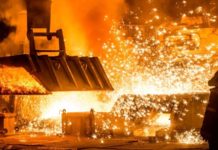
[miningmx.com] – AS IF further evidence were needed, Anooraq
Resources’ annual results today provide ample evidence of why it was crucial to have
recapitalised the company. Production had not improved since 2009, while costs were
marching remorselessly higher.
Worse, the 16% interest rate on R3bn worth of debt was company-breaking. Anooraq
simply wouldn’t have survived – an outcome its partner, Anglo American Platinum,
could not have countenanced, apparently at any price.
Before turning to the future of Anooraq, as set forth when news of the refinancing
was finally released to the market on February 2, let us take one last glance at the
entropy that was at the heart of the company last year.
The company’s operating margin had disappeared falling from a slim 4.3% in the 2010
financial year to a negative 16% in the 2011 financial year. The outcome was a pretax
loss of R46m compared to a R13m loss in the 2010 financial year, and a R147m loss
after tax – compared to a negative R93m in the previous year. Horrible.
The future, as Anooraq would like us to understand it, turns exclusively on the
accelerated development programme at its Bokoni Platinum operation at the north-
eastern extreme of the Bushveld complex. The programme consists of two “mines’
known as the Brakfontein decline and the Middelpunt Hill adit, which sit either side of
the largely mined-out UM2 incline shaft and the vertical shaft.
With Anooraq’s debt cut to R1bn and with Anglo American Platinum sharing half of the
R2.6bn in capital development for the accelerated programme (in equity), Bokoni now
has a two to three-year window to start opening up quality, lower cost ounces. That’s
why there’s zero interest on the debt finance offered to Anooraq over that time – to
give Bokoni every possible chance to make Middelpunt Hill and Brakfontein Decline a
success.
In that time, Bokoni needs three more ventilation shafts at its Middelpunt Hill
development in order to descend from 6 level to 9 level, some 650m – shafts not
initially factored into the project. Simultaneously, the old UM2 incline will be powered
down with less capital allocated to it.
Then there’s Anooraq’s secret weapon. Bokoni’s newly appointed on-site Mine
Manager, Dawid Stander, operated Bokoni once before when it was the struggling as
Lebowa Platinum, then under the management of Anglo Platinum’s CEO and, later,
Chairman, Barry Davison. Stander turned Lebowa around then, and the likes of
Anooraq’s Business Development Director, Joel Kesler, is hoping Stander can stage a
repeat performance.
There are some early signs. Milling levels at Bokoni in March were best ever, while
Stander is attracting other mining talent to the operation. There’s also a plan to
explore for early ounces from the 20 km strike length on the northern boundary, where
possible outcrops could allow open cast mining. Mining from such outcrops could begin
as early as the third quarter of this calendar year, bearing in mind that Bokoni has
milling capacity of 160,000 tonnes but is currently only filling 100,000 tonnes’ worth.
And there’s nothing like experience either. Productivity at the mine dips markedly
each Friday at month-end as miners leave for town to settle with loan sharks and the
like. Stander has, one hears, changed to a weekly payment cycle where miners club
together in a stovel covering each others’ debts.
Equally importantly, there’s no cap on performance rewards, but the performance is
on ounces, not tonnes of rock. Either way, the unions are asking if and how they can
schedule public holiday work.
Bokoni has had many false dawns (this is its third financing from Anglo American).
This is surely its last chance to make it work.











